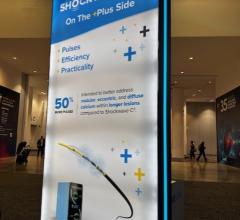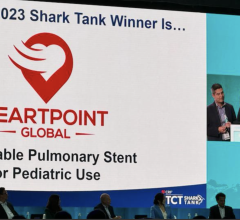October 27, 2015 — Results from the multicenter, prospective, randomized PANDA III trial indicate that the BuMA sirolimus-eluting stent (SES) was non-inferior to the Excel SES for the primary endpoint of target lesion failure at one year. The trial specifically examined whether the rate of drug elution and polymer absorption affects the clinical outcomes of two bioresorbable polymer-based drug-eluting stents (DES).
Findings were reported at the 27th annual Transcatheter Cardiovascular Therapeutics (TCT) scientific symposium, sponsored by the Cardiovascular Research Foundation (CRF), Oct. 11-15 in San Francisco.
The PLGA polymer-based BuMA SES from SinoMed has a unique design that incorporates an electro-grafting (eG) base layer between the polymer and stent strut, securing adhesion of the PLGA coating. Sirolimus is 100 percent eluted within 30 days, and the PLGA polymer is completely absorbed within three months. In contrast, the PLA polymer-based Excel SES elutes sirolimus completely within 180 days and the PLA polymer is completely absorbed within six to nine months. Both stents elute sirolimus from a stainless steel platform, allowing for a more specific and controlled comparison of the direct effects of polymer and elution kinetics upon clinical outcomes.
PANDA III enrolled 2,348 patients randomized in a 1:1 ratio to receive a BuMA (N=1,174) or Excel (N=1,174) SES at 46 centers in China. At one-year follow-up, the primary endpoint of target lesion failure (TLF, the composite of cardiac death, target vessel myocardial infarction or ischemia-driven target lesion revascularization) was 6.4 percent for BuMA (N=1,169) and 6.4 percent for Excel (N=1,164), a difference of 0.06 percent (Pnoninferiority= 0.0003). The primary non-inferiority endpoint was met, and there were no significant differences in other major secondary endpoints. However, BuMA was also associated with a lower rate of stent thrombosis compared to JW Medical Systems’ Excel (0.5 percent vs. 1.3 percent, P=0.047).
“Results from the PANDA III study show that the BuMA SES was non-inferior to the Excel SES for the primary endpoint of target lesion failure at one year,” said co-principal investigator Bo Xu, MBBS, director, catheterization laboratories at Fu Wai Hospital in Beijing, China.
“The BuMA SES was also associated with a lower incidence of stent thrombosis compared to the Excel SES which is consistent with previous findings of enhanced strut coverage with this device. Longer follow-up is needed to further understand the long-term effects of this emerging stent technology,” he added.
The study was funded by a research grant from SinoMed (Tianjin, China). Xu reported no relevant conflicts of interest.
For more information: www.tctconference.com


 October 16, 2024
October 16, 2024 








